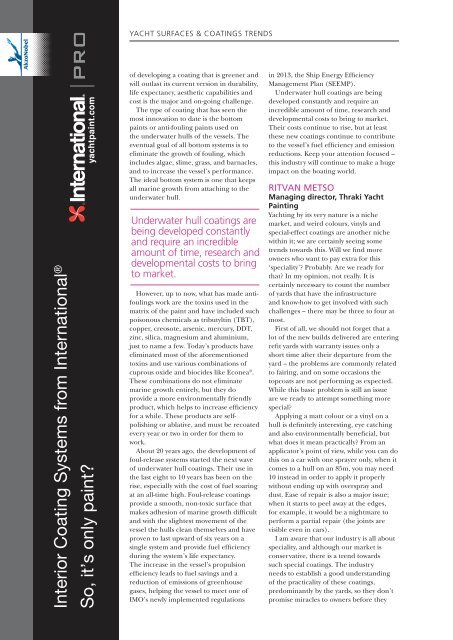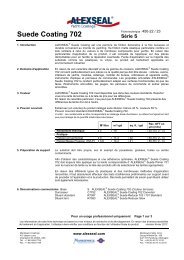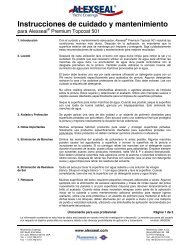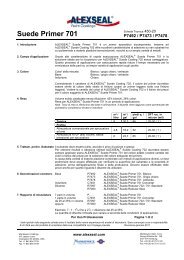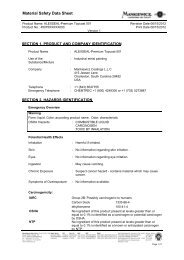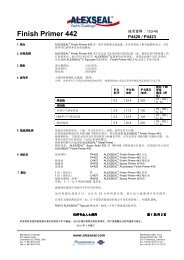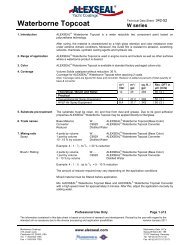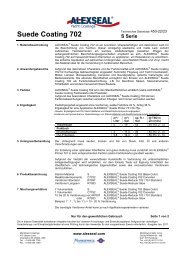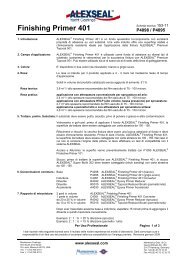yacht surfaces & coatings trendsInterior Coating Systems from International ®So, it’s only paint?of developing a coating that is greener andwill outlast its current version in durability,life expectancy, aesthetic capabilities andcost is the major and on-going challenge.The type of coating that has seen themost innovation to date is the bottompaints or anti-fouling paints used onthe underwater hulls of the vessels. Theeventual goal of all bottom systems is toeliminate the growth of fouling, whichincludes algae, slime, grass, and barnacles,and to increase the vessel’s performance.The ideal bottom system is one that keepsall marine growth from attaching to theunderwater hull.Underwater hull coatings arebeing developed constantlyand require an incredibleamount of time, research anddevelopmental costs to bringto market.However, up to now, what has made antifoulingswork are the toxins used in thematrix of the paint and have included suchpoisonous chemicals as tributyltin (TBT),copper, creosote, arsenic, mercury, DDT,zinc, silica, magnesium and aluminium,just to name a few. Today’s products haveeliminated most of the aforementionedtoxins and use various combinations ofcuprous oxide and biocides like Econea ® .These combinations do not eliminatemarine growth entirely, but they doprovide a more environmentally friendlyproduct, which helps to increase efficiencyfor a while. These products are selfpolishingor ablative, and must be recoatedevery year or two in order for them towork.About 20 years ago, the development offoul-release systems started the next waveof underwater hull coatings. Their use inthe last eight to 10 years has been on therise, especially with the cost of fuel soaringat an all-time high. Foul-release coatingsprovide a smooth, non-toxic surface thatmakes adhesion of marine growth difficultand with the slightest movement of thevessel the hulls clean themselves and haveproven to last upward of six years on asingle system and provide fuel efficiencyduring the system’s life expectancy.The increase in the vessel’s propulsionefficiency leads to fuel savings and areduction of emissions of greenhousegases, helping the vessel to meet one ofIMO’s newly implemented regulationsin 2013, the Ship Energy EfficiencyManagement Plan (SEEMP).Underwater hull coatings are beingdeveloped constantly and require anincredible amount of time, research anddevelopmental costs to bring to market.Their costs continue to rise, but at leastthese new coatings continue to contributeto the vessel’s fuel efficiency and emissionreductions. Keep your attention focused –this industry will continue to make a hugeimpact on the boating world.Ritvan MetsoManaging director, Thraki <strong>Yacht</strong>Painting<strong>Yacht</strong>ing by its very nature is a nichemarket, and weird colours, vinyls andspecial-effect coatings are another nichewithin it; we are certainly seeing sometrends towards this. Will we find moreowners who want to pay extra for this‘speciality’? Probably. Are we ready forthat? In my opinion, not really. It iscertainly necessary to count the numberof yards that have the infrastructureand know-how to get involved with suchchallenges – there may be three to four atmost.First of all, we should not forget that alot of the new builds delivered are enteringrefit yards with warranty issues only ashort time after their departure from theyard – the problems are commonly relatedto fairing, and on some occasions thetopcoats are not performing as expected.While this basic problem is still an issueare we ready to attempt something morespecial?Applying a matt colour or a vinyl on ahull is definitely interesting, eye catchingand also environmentally beneficial, butwhat does it mean practically? From anapplicator’s point of view, while you can dothis on a car with one sprayer only, when itcomes to a hull on an 85m, you may need10 instead in order to apply it properlywithout ending up with overspray anddust. Ease of repair is also a major issue;when it starts to peel away at the edges,for example, it would be a nightmare toperform a partial repair (the joints arevisible even in cars).I am aware that our industry is all aboutspeciality, and although our market isconservative, there is a trend towardssuch special coatings. The industryneeds to establish a good understandingof the practicality of these coatings,predominantly by the yards, so they don’tpromise miracles to owners before they
are ready. When/if this trend reachesa maturation of understanding andexpectation then we, as applicators, mustinvent techniques combined with intensivetraining so that we can continue to deliverquality on today’s coatings.Tripp NelsonSales and marketing director,<strong>Alexseal</strong> <strong>Yacht</strong> <strong>Coatings</strong>Mankiewicz <strong>Coatings</strong> (the parent companyof <strong>Alexseal</strong> <strong>Yacht</strong> <strong>Coatings</strong>) has seen atrend of yacht finish enquiries followingthe automotive and aerospace markets interms of colour, special effects and design.In today’s high-end automotive market,matt finishes on cars such as BMW havedrawn yacht owners to request these uniquefinishes on their yachts. We saw the sametrend toward metallic finishes. Owners see aunique finish they like and want to duplicateit on their yacht.The significantly larger paintsurfaces of a 30m yacht createunique challenges when tryingto apply and repair metallic,matt or other special finishes.The significantly larger paint surfacesof a 30m yacht create unique challengeswhen trying to apply and repair metallic,matt or other special finishes. It isimportant to recognise the downsideof using these finishes and to thereforemanage the expectations of both ownersand applicators. For example, a matt finishmust be applied to a hard tapeline thatcannot be polished. Polishing a matt finishwill make it a gloss finish. Matt finishesalso become challenging from the effectsof daily use. Fenders, placed on the hull toprotect the yacht, will rub or ‘polish’ sheeninto a matt finish.Repairing unique finishes on a yacht mayalso create challenges. While automobilerepairs involve painting an entire smallpanel, yacht repairs involve painting only aportion of a much larger panel. Blendingunique finishes during a yacht repair cancreate visual differences and thereforerequire more break lines to minimisepainting a portion of a panel.Another trend in automobiles ischrome finishes. Chrome finishes maywork on reflective surfaces and even onthe Mercedes Formula 1 car. However,chrome must be applied using steam in avacuum-sealed environment, a technologythat is not yet available for large-yachtapplications.Each yacht is unique and the yacht’sexterior styling is the first expression ofthat uniqueness. Its paint finish can also beunique as long as all involved understand thetechnology being used. Metallic and mattfinishes may turn heads at the marina, butif durability and reparability are the priority,nothing beats a simple, high gloss whitefinish.Marcus ReynoldsMegayacht brand manager, Jotun<strong>Coatings</strong>In the last few years we have seen bothdesigners and owners following theautomotive fashion trends with metalliccolours and pearlescent finishes, which canbe difficult to apply and achieve a finishthat all parties will accept and be happywith. Matt finishes again are a similar trendcoming from the automotive market withsome of the latest high-quality cars, suchas matt grey McLaren MP4-12C and mattblack Porsche etc, and we have reactedto this trend by developing a mattingagent that can be added to Megagloss HGtopcoat.We are seeing a trend of standardyacht solid colours but with a slight twist– customers requesting special variationson a colour, enabling them to have theirown individual or bespoke registeredcolour shade. This ensures that their yachtis different from the neighbouring boatand they know their yacht paint colour is‘special’.Another advancement is silyl acrylate,using hydrolysis as its polishing mechanism.This is recognised as today’s most advancedself-smoothing and self-polishing antifoulingtechnology. The whole paint filmis smoothed away throughout its life,preventing fouling at a consistent ratefrom start to finish, therefore reducing theroughness of the hull and also providingoutstanding protection against algae andslime.There are new ideas of using heatabsorbingpigments, and insulatinginterior coatings, especially for use on verydark coloured yacht hulls that regularlysail in very hot climates (the Caribbean,Persian Gulf, etc.). This reduction of heattransfer within the yacht could reducethe demand on air-conditioning units,generators and so on, saving fuel andtherefore helping to reduce the yacht’scarbon footprint as well as being better forour environment in the long run.Cut solvent emissions by 50% – Lloyds Surface Spread of Flame certifiedInterior Finish 770 is a high performancepolyurethane satin finish. Suitable for all areasof a yacht interior where a high gloss systemmay not be desirable. The uniform finish alsomakes it suitable for deckheads. Available inwhite and white (RAL 9003).Interior Finish 750 comes in 4 RAL matchedshades and provides a high gloss, high opacityfinish that is tough, chemically resistant andeasy to clean. Interior Finish 750 is particularlysuited for use in engine rooms.Interior Primer 860 delivers a long-lasting,high performance anticorrosive coating in alow odour formulation, which is quick-dryingand has extended over-coating intervals. It issuitable for use in all areas of a yacht’s interior,including wet areas such as bilges and is alight weight alternative to polyester flowcoat –increasing fuel savings.Visit us at yachtpaint.com and let’s discuss our passion for your business. Our World is Water, International and the AkzoNobel logo are trademarks of AkzoNobel. © AkzoNobel 2013.


